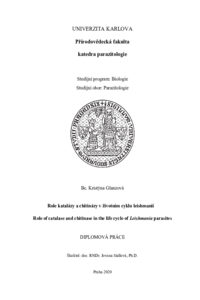Role katalázy a chitinázy v životním cyklu leishmanií
Role of catalase and chitinase in the life cycle of Leishmania parasites
diplomová práce (OBHÁJENO)

Zobrazit/
Trvalý odkaz
http://hdl.handle.net/20.500.11956/119920Identifikátory
SIS: 208037
Kolekce
- Kvalifikační práce [21483]
Autor
Vedoucí práce
Oponent práce
Kodym, Petr
Fakulta / součást
Přírodovědecká fakulta
Obor
Parazitologie
Katedra / ústav / klinika
Katedra parazitologie
Datum obhajoby
20. 7. 2020
Nakladatel
Univerzita Karlova, Přírodovědecká fakultaJazyk
Čeština
Známka
Velmi dobře
Klíčová slova (česky)
Leishmania, Lutzomyia, Phlebotomus, kataláza, chitináza, peritrofická matrix, stomodeální valva, metacyklogenezeKlíčová slova (anglicky)
Leishmania, Lutzomyia, Phlebotomus, catalase, chitinase, peritrophic matrix, stomodeal valve, metacyclogenesisLeishmanióza je infekční onemocnění působené dvojhostitelskými prvoky rodu Leishmania (Kinetoplastida: Trypanosomatidae) přenášenými flebotomy (Diptera: Phlebotominae). Leishmanie jsou pro svůj životní cyklus vybaveny enzymatickou výbavou, která jim pomáhá úspěšně přežívat jak v hmyzích přenašečích, tak v savčích hostitelích. Enzym kataláza, který odstraňuje H2O2 a chrání tedy buňky před reaktivními formami kyslíku, v genetické výbavě leishmanií chybí, ač je přítomný u příbuzných jednohostitelských trypanosomatid. Enzym chitináza se může uplatňovat v interakci leishmanií s chitinózními strukturami ve flebotomech (peritrofická matrix, stomodeální valva) a jelikož je produkován i amastigoty, mohl by hrát roli i v hostiteli. Roli těchto dvou enzymů v životním cyklu leishmanií jsem testovala pomocí přímého srovnání mutantních linií L. mexicana s vloženým genem pro katalázu a s deleci genu pro chitinázu s kontrolními skupinami. Prováděla jsem experimentální infekce flebotomů druhu Lu. longipalpis včetně přenosu leishmanií na hostitele, testovala přežívání leishmanií v makrofázích a prováděla experimentální infekce BALB/c myší s následnými xenodiagnostickými pokusy. Přítomnost katalázy neovlivnila příliš schopnost množení a přežívání leishmanií ve flebotomech, naše pokusy ale potvrdily neslučitelnost...
Leishmaniasis is an infectious disease caused by protozoa of the genus Leishmania (Kinetoplastida: Trypanosomatidae) which are transmitted by phlebotomine sand flies (Diptera: Phlebotominae). For the dixenous life cycle, leishmania parasites are equipped with enzymes that facilitate survival in both insect vectors and mammalian hosts. Gene for the enzyme catalase which protects cells from reactive oxygen species by the elimination of H2O2 and is present in related monoxenous trypanosomatids is, however, missing in Leishmania genome. Chitinase can be involved in the interaction of leishmania parasites with chitin-containing structures in sand flies (peritrophic matrix, stomodeal valve). The expression of the enzyme in amastigotes suggests its significant function also in the mammalian host. I tested the role of these enzymes in the life cycle of leishmania by direct comparison of L. mexicana mutants (i) with inserted catalase gene and (ii) with deleted chitinase gene with control groups. I conducted experimental infections of Lu. longipalpis including transmission of leishmania to the hosts by bite, tested the survival of leishmania in macrophages and performed experimental infections of BALB/c mice followed by xenodiagnoses. The experiments confirmed that the presence of catalase in leishmania does...
